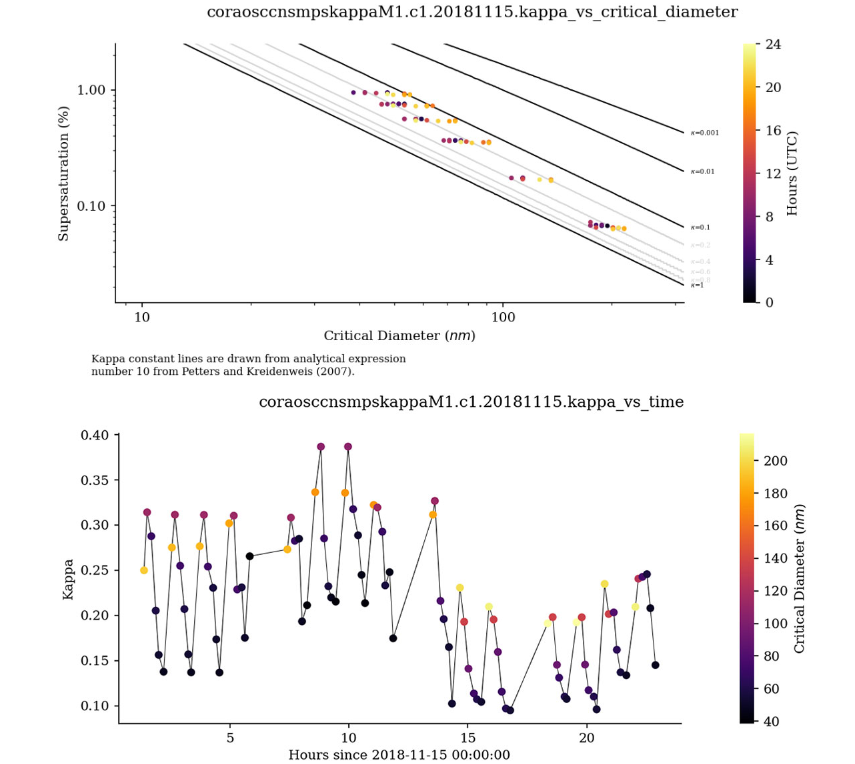New Aerosol Hygroscopicity Kappa Data Released for 3 ARM Sites
Published: 18 May 2022

Hygroscopicity is the ability of a particle to take up moisture from the environment and is important for understanding the formation of cloud condensation nuclei (CCN). New data from a value-added product (VAP) that calculates the hygroscopic properties of measured aerosol particles are available for three Atmospheric Radiation Measurement (ARM) user facility sites.
The CCN Counter and Scanning Mobility Particle Sizer (SMPS) Derived Hygroscopicity Parameter Kappa (CCNSMPSKAPPA) VAP is now in production for ARM’s Southern Great Plains atmospheric observatory. Production data are also available from the 2018–2019 Cloud, Aerosol, and Complex Terrain Interactions (CACTI) field campaign in Argentina. Evaluation data were previously produced for both sites.
In addition, users can now access evaluation data from the 2016–2017 Layered Atlantic Smoke Interactions with Clouds (LASIC) campaign on Ascension Island in the South Atlantic Ocean.
The hygroscopicity parameter, kappa, quantifies a particle’s capacity to activate into a water droplet. This kappa product provides a means to quantify hygroscopic properties of ambient aerosols and could be used to evaluate aerosol properties simulated in global earth system models.
The ARM CCN particle counter measures the fraction of ambient aerosols that can become liquid droplets at five supersaturations. These CCN and co-located dry aerosol particle size measurements from the SMPS are used to calculate the critical diameter—the minimum particle diameter required to activate into a water droplet. For each critical diameter value, kappa is calculated using the kappa-Köhler theory (Petters and Kreidenweis 2007).
Scientists can use the aerosol hygroscopicity kappa VAP to help improve the understanding of aerosol-cloud interaction treatment in global earth system models.
For the Southern Great Plains E13 site near Lamont, Oklahoma, daily netCDF files are available starting from April 12, 2017. The CACTI and LASIC data are also available as daily netCDF files.
Future work will involve expanding the availability of this product at more ARM sites where CCN particle counter and SMPS data are available. Data are coming soon from the 2019–2020 Multidisciplinary Drifting Observatory for the Study of Arctic Climate (MOSAiC) expedition in the central Arctic and the 2021–2023 Surface Atmosphere Integrated Field Laboratory (SAIL) campaign near Crested Butte, Colorado.
To learn more about this product, go to the VAP web page.
If you have questions or feedback to help improve this data product, please contact data scientist Gourihar Kulkarni, ARM translator John Shilling, or VAP developer Maxwell Levin.
Access the data in the ARM Data Center. (Go here to create an account to download the data.)
Data can be referenced as doi:10.5439/1729907.
Reference: Petters MD and SM Kreidenweis. 2007. “A single parameter representation of hygroscopic growth and cloud condensation nucleus activity.” Atmospheric Chemistry and Physics, 7, 1961–1971, https://doi.org/10.5194/acp-7-1961-2007.
Keep up with the Atmospheric Observer
Updates on ARM news, events, and opportunities delivered to your inbox
ARM User Profile
ARM welcomes users from all institutions and nations. A free ARM user account is needed to access ARM data.


















